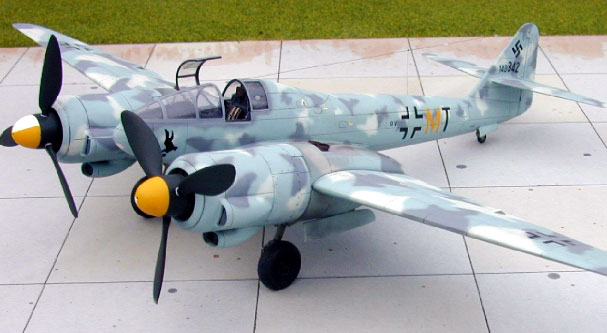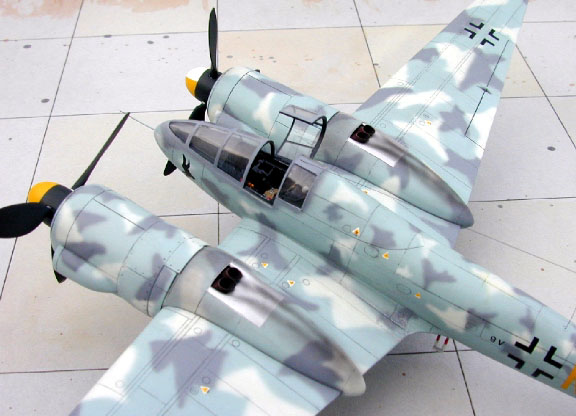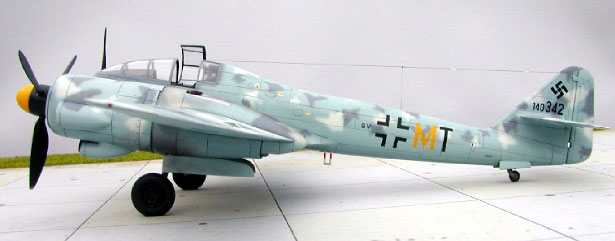|
Messerschmitt
Me 246C Adler
by
Mike Braun
 |
|
Messerschmitt
Me 246C Adler |
images by
Alan
Del Paggio

Tamiya's 1/48 scale Dinah
is available online from Squadron.com
In 1942 the Luftwaffe found itself sorely in need of a fast,
high-flying, twin engine aircraft. The Messerschmitt Me 110 was ineffective in
its intended role and the Me 210 was an aeronautical disaster. The German High
command seriously considered license building the Mitsubishi Ki-46.
Through the Nippon-German technical exchange program, a few
Ki-46s were evaluated. It was soon discovered that although it was an excellent
aircraft, its total lack of defenses, (crew and airframe amor plating,
self-sealing fuel tanks, etc.) made it unsuitable for war in Europe.
But what if...
| The
Messerschmitt Me 246C Adler (Eagle) |
The History That Might Have Been...
Because of the lacklustre performance of the Messerschmitt Bf 110 and the debacle of the
Me 210, Professor Willy Messerschmitt was ordered to improve and produce the
vaunted Japanese design. Shamed into submission, he began a successful production
run of high altitude photo-reconnaissance aircraft. The Me 146 series was
essentially a copy of the Japanese design substituting BMW 801A engines for the
Mitsubishi powerplants.
In 1944 the need for an even faster and higher flying photo-bird was realized
and the Me 146 was radically modified. The rear cockpit was removed and the
vacated area filled with larger fuel tanks and a water-methanol boost tank. The
now single seat cockpit was reinforced to allow for pressurization. The wingspan
was increased from 48 feet, 3 inches to 62 feet, 5 inches. To counteract engine
torque and improve directional stability a new, taller tail similar to the
Me-262 was installed. A large rudder trim tab and variable tailplane incidence
adjusted the attitude of the aircraft as the large amount of fuel was
spent.
The powerplants were the BMW 801 TJ, modified to use two turbo-superchargers
and large intercoolers. Driving VS-9 propellers, these powerplants were capable
of generating 2200 horsepower at an amazing 40,000 feet. In emergencies or while
flying over the photo-target area, MW-50 water-methanol injection could be
engaged, adding another 300 hp per engine. With 5000 hp, cockpit pressurization,
and the large wing area, altitudes of over 50,000 ft at speeds in excess of 500
mph were easily attainable.

To increase range the aircraft's design had come full circle. All armor
plating, self-sealing fuel tanks, and any unnecessary equipment was removed to
make room to carry as much fuel as possible. Speed and altitude were its only
defense. A Loft 21C telescopic range finding sighting system controlled the
long-range cameras. To use the sight the pilot set the autopilot, swung the
control column to the side, knelt forward, and using the controls on the sight,
flew the aircraft much like a bombardier using a Norden bombsight.
Had the Germans developed such an aircraft, the "eyes" of their
forces could have foreseen much of what the Allies had planned during 1944 and
1945, and possibly delayed the end of the war until more of the radical
"Wonder Weapons" could have been utilized… hypothetically speaking!
Tamiya's Dinah is a beautiful kit of a beautiful aircraft. I wanted to do
something a bit different and while reading that the Luftwaffe actually did
test a few Dinahs the idea came to me.
Building "dreamed up" hypothetical models is a way for me to relax
after the intense, self-imposed rivet counting associated with my usual modeling
projects.
For the Adler, I started by cutting down the rear fuselage and filling
the area in with sheet plastic.

The tail was borrowed from an old Monogram Me-262, as were the extensions for
the wing tips and the main wheels. The engine cowlings are a $4.00 swap-meet
scored Highflight conversion to build a Ju-88 G-1 out of the less than perfect
Hobbycraft kit. The prop blades and spinners were bagged from two of my many DML
Fw 190 D-9 kits. (Wurger Mechanic prop and spinners are now in my 190 boxes) The
oil cooler and intercooler scoops were cobbled up out of the spare parts box
along with little extra doo-dads to spruce up the cockpit. The exhaust pipes are
resin copies of some Ki 44 Tojo pipes.
The paint scheme is pure speculation depicting what I think a high altitude
aircraft should look like.
Markings came from various decal sheets. The nose art was cut from black
decal film and depicts an eagle carrying a camera.
I had tons of fun building this model. One of the highest compliments I have
ever had for any of my models came from several people wanting to know if I had
resin copies of the parts so they could build their own Adlers!
Click the thumbnails below to view
larger images:
Model, Images and
Article Copyright © 2002 by Mike Braun
Images Copyright © 2002 by Alan Del Paggio
Page Created 02 Januray 2002
Last updated 04 June 2007
Back to HyperScale Main Page
Back to Features Page |
Home
| What's New |
Features |
Gallery |
Reviews |
Reference |
Forum |
Search